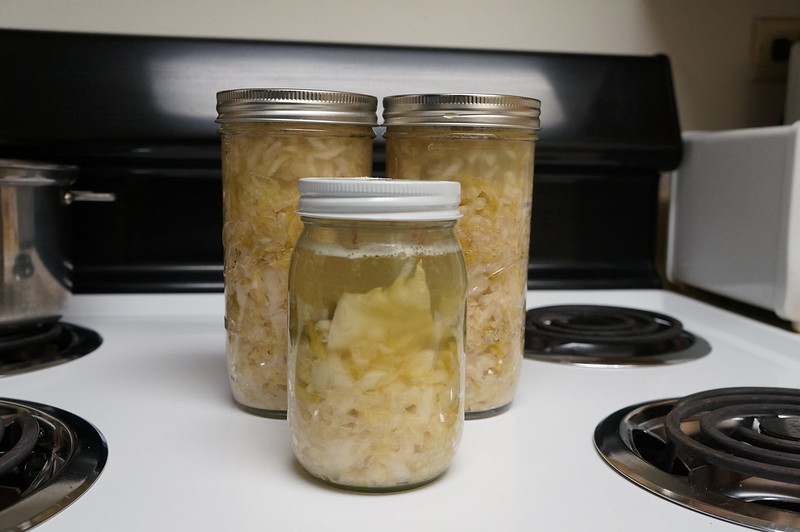Laura Poe isn’t necessarily a fan of exclusion diets.
A private practice dietitian based in Viroqua, Poe’s philosophy is quite the opposite: work with her clients to learn what’s missing in their diets and then come up with a plan to help them add in more healthful ingredients.
One of her favorites to include in a healthy diet is fermented foods.
Stay informed on the latest news
Sign up for WPR’s email newsletter.
Fermentation is the practice of transforming foods through microbial activity. One of the biggest health benefits of the fermentation process is that the foods become much more digestible, she said.
“The nutrients in them become more absorbable to our bodies,” she said, for example the lactose in dairy, which can cause gastrointestinal pain for many people, is mostly broken down through fermentation.
One of the reasons fermented foods are so healthy has to do with the probiotics in them.
“They have beneficial bacteria and other microbes, even beneficial yeasts and things like that, that contribute to overall health, especially digestive health,” she said.
Probiotics can be bought as supplements, but Poe said a teaspoon of fermented food has millions and sometimes billions of total live bacteria.
“That’s a heck of a lot cheaper than a bottle of probiotics,” she said.
Also, Poe said the fermentation process can increase the amount of certain vitamins in food, for example B12 and K2. The fermentation process doesn’t degrade naturally-occurring vitamins such as C because there’s no heat or pressure treatment applied in the process like there is for canning.
Types of fermented foods
Fermented foods that people are most likely familiar with include sauerkraut and yogurt, but Poe said there are lots of other food and drink options out there.
Miso is a paste made out of fermented soybeans, like tempeh and grains.
Kimchi is similar to sauerkraut but spicier and hails from Korea.
Kefir is a fermented dairy beverage that’s similar to but thinner than yogurt. Water kefir is a variation of the dairy beverage that’s fermented with a culture to make it probiotic and fizzy.
Kombucha is a fermented tea beverage that’s heavily carbonated because of both bacterial and yeast fermentation that occurs.
It requires a starter culture that you use to ferment sweetened tea. That creates a sweet and acidic carbonated beverage. Poe advised that if you’re going to buy kombucha from a grocery store, make sure it hasn’t been pasteurized. She said this might not be the best option if you’re looking for a decaffeinated beverage, because it requires black tea.
“The microbes in the kombucha — this combination of bacteria and yeast — really like a certain pH and there’s tannins in tea that kind of helps control the environment,” she said.
Some breads, such as sourdough, have gone through fermentation. The baking process kills the probiotics, however.
“But it still has some health benefits because it went through fermentation,” Poe said.
Making sauerkraut
Sauerkraut is easy to make, Poe said, and can kick off your journey into fermenting.
The first step is chopping up the cabbage, which you can shred finely or leave in big chunks, depending on your preference.
Then, spread the cabbage out and add salt. Use one teaspoon of salt per pound of cabbage. That same ratio applies if you want to add any kind of vegetable.
“But you mostly want to use cabbage because it’s the perfect fermentation vessel, because it stays crunchy, and it has a high water content,” she said.
The next step is to massage the cabbage. Wring it through your hands to break up the cell walls and release the water that’s stored in the cabbage. When mixed with the salt, it creates your brine.
Massaging can take five or 10 minutes to squeeze as much water as possible from the cabbage. Once the cabbage is massaged and soft, pack it into a storage container such as a glass jar.
Use a wooden spoon and pack the cabbage down as much as possible.
“That kind of pushes up all the brine and also kind of gets rid of any air bubbles,” Poe said, further explaining that the bacteria in the sauerkraut want an anaerobic, or oxygen-free, environment.
Let the brine rise to the top so you see a layer of liquid above the vegetables.
You’ll want to use a fermentation weight to keep everything submerged. That will help prevent mold, off-flavors and browning, she said.
Cover with a lid and let sit for about two weeks at room temperature. Check for mold and make sure the vegetables stay submerged. Once it’s done, you can taste it with a fork to see if it’s to your liking.
Then, transfer to the refrigerator, where it will keep for about a year.
Poe shares recipes on her Instagram, brineandbroth, and also posts links to workshops and lectures that she gives on skills related to fermenting and cooking.
Wisconsin Public Radio, © Copyright 2025, Board of Regents of the University of Wisconsin System and Wisconsin Educational Communications Board.






